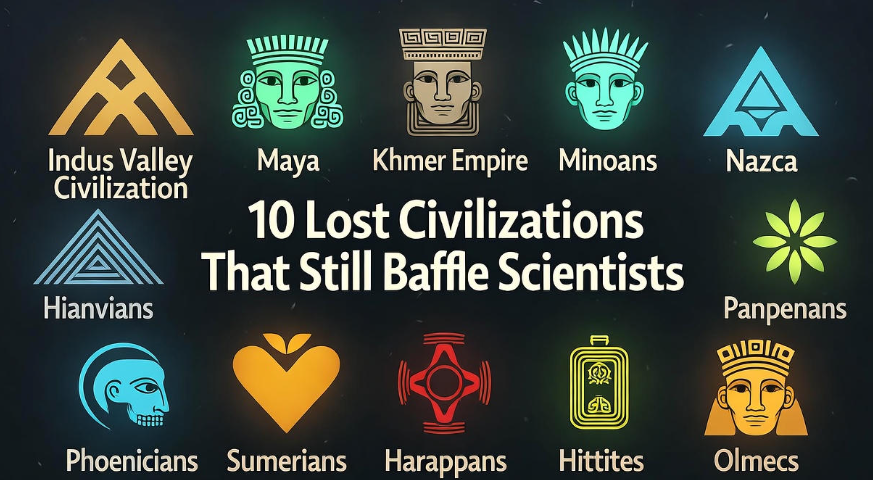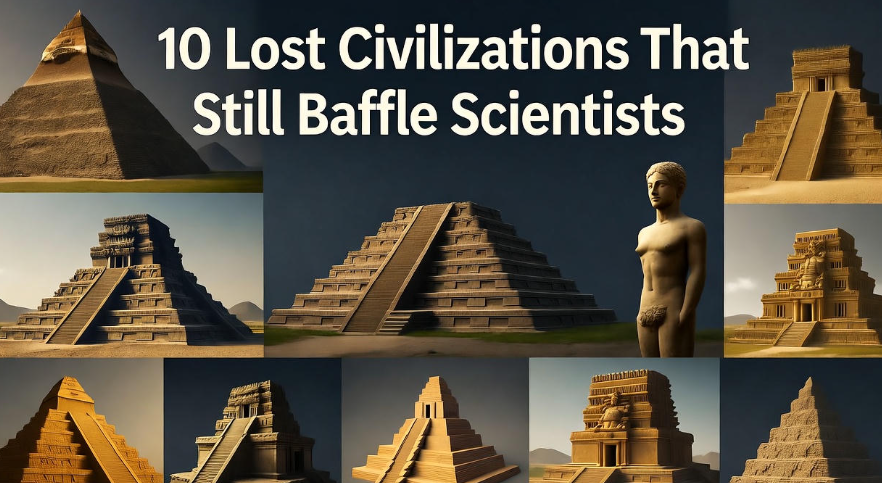It’s hard to imagine entire civilizations disappearing off the face of the Earth, leaving behind only mysterious ruins, strange symbols, and questions with no clear answers. Yet, that’s exactly what has happened time and again throughout history. Some of these societies were once advanced, organized, and thriving—but now, all that remains are whispers of their existence. 🌍
Below are 10 lost civilizations that continue to puzzle scientists, historians, and archaeologists even today.
1. The Indus Valley Civilization 🏺
The Indus Valley Civilization, also known as the Harappan Civilization, was one of the earliest urban societies in human history. Located in what is now Pakistan and northwest India, it flourished around 2500 BCE.
What makes it mysterious? Well, despite its advanced cities, drainage systems, and trade routes, we still can’t read their written language. The people of this civilization left behind thousands of inscribed seals—but their script remains undeciphered. Without being able to read what they wrote, historians are left guessing how they lived, what they believed, and why they disappeared.
Some scientists believe climate change or river shifts led to their decline. Others think they simply migrated elsewhere. Whatever the reason, the fall of the Indus Valley remains one of the biggest historical mysteries.
2. The Maya Civilization 🌿
The Mayans were brilliant astronomers, architects, and mathematicians. They built massive stone pyramids, observed stars with precision, and developed one of the most accurate calendars ever created.
But around 900 CE, many of their great cities—like Tikal and Copán—were suddenly abandoned. Why? That’s still unclear. Some experts think droughts and resource depletion caused collapse; others suggest internal wars or disease.
Interestingly, the Mayan descendants still live in Central America today, but the cause of the classic Maya collapse remains one of archaeology’s greatest enigmas.
| Mystery Element | Possible Explanation |
|---|---|
| Sudden city abandonment | Drought, famine, or war |
| Hieroglyphic records | Still not fully translated |
| Advanced astronomy | Linked to religion and farming |
3. The Ancient City of Atlantis 🌊
Ah, Atlantis—the legendary lost city that has inspired explorers, dreamers, and conspiracy theorists for centuries. First mentioned by Plato around 360 BCE, Atlantis was said to be a powerful island civilization that sank into the sea “in a single day and night.”
Was it real? Scientists are divided. Some think it was purely symbolic—a cautionary tale about human greed and pride. Others believe it might have been inspired by real events, such as the Minoan eruption on Santorini, which destroyed an advanced Bronze Age civilization around 1600 BCE.
To this day, no one has found definitive proof of Atlantis, yet the legend refuses to die. 🌊
4. The Ancestral Puebloans (Anasazi) 🏜️
The Ancestral Puebloans once thrived in the deserts of the American Southwest. They built massive stone dwellings inside cliffs—most famously at Mesa Verde and Chaco Canyon.
Then, suddenly, around the 13th century, they vanished. Their cities were abandoned, and no one knows exactly why.
Archaeologists suggest that prolonged droughts or resource shortages forced them to migrate. However, there’s also evidence of conflict and social unrest. Their disappearance still stirs curiosity among scientists and travelers alike.
5. The Minoan Civilization 🇬🇷
Before ancient Greece rose to power, the island of Crete was home to the Minoan civilization (2600–1400 BCE). The Minoans were skilled traders, artists, and builders—best known for the Palace of Knossos, a labyrinth-like structure that may have inspired the myth of the Minotaur.
But around 1450 BCE, the Minoan world collapsed. Archaeologists found evidence of a massive volcanic eruption on nearby Santorini that could have caused tsunamis and destroyed crops. Yet, the full story remains unclear—were they wiped out by nature, invasion, or both?
Even today, the Minoans’ peaceful yet powerful culture fascinates historians who still can’t quite explain how such an advanced people disappeared almost overnight.
6. The Nabataeans and the Lost City of Petra 🏜️
If you’ve ever seen pictures of Petra—the stunning rock-carved city in modern-day Jordan—you’ve glimpsed the brilliance of the Nabataeans. They were master engineers who turned desert cliffs into breathtaking architecture and controlled vital trade routes.
But by the 4th century CE, they were gone. Petra was abandoned and eventually forgotten, buried beneath sand until rediscovered in the 19th century.
Some think shifting trade routes led to their decline. Others believe earthquakes destroyed their water systems. Despite the mystery, Petra still stands as one of the most awe-inspiring remnants of a forgotten empire. 🏛️
7. The Khmer Empire (Angkor) 🌳
Deep in Cambodia’s jungles lies Angkor Wat, the heart of the ancient Khmer Empire. Between the 9th and 15th centuries, the Khmer built an immense city with sophisticated irrigation systems that supported millions.
Yet, the empire eventually fell apart, and its capital was swallowed by the jungle. Scientists now believe a mix of factors caused this—climate instability, deforestation, and political conflict.
Satellite imaging and LIDAR scans recently revealed that Angkor was once the largest pre-industrial city in the world. Still, how such a grand civilization faded remains one of Southeast Asia’s greatest mysteries.
8. The Olmec Civilization 🗿
Long before the Aztecs or Mayans, the Olmecs thrived along Mexico’s Gulf Coast around 1200 BCE. They’re famous for their colossal stone heads, some weighing up to 40 tons.
But here’s the strange part: we know almost nothing about them. Their writing system remains undeciphered, and their political or religious systems are largely unknown.
Around 400 BCE, the Olmecs disappeared without clear reason. Some researchers suspect volcanic activity or environmental change—but again, there’s no solid proof. Their mysterious sculptures and monuments are the only clues left behind.

9. The Cahokia Civilization (North America) 🏞️
In what is now Illinois, near modern-day St. Louis, the Cahokia civilization once built an enormous city around 1050 CE. At its height, Cahokia was larger than London at the time, featuring giant earth mounds, plazas, and organized streets.
And then… it vanished. No written records exist, and historians can only guess what happened. Environmental stress, overpopulation, and social unrest are possible causes.
The biggest mystery? How such a massive and sophisticated society could disappear almost completely, leaving behind so little evidence of its daily life.
10. The Rapa Nui (Easter Island) Civilization 🗿
The isolated island of Rapa Nui, better known as Easter Island, is famous for its mysterious stone statues called Moai. These giant heads have puzzled the world for centuries—how were they built, and why were they made?
The Rapa Nui people flourished for centuries before facing collapse around the 17th century. Many theories suggest they overused their resources, cutting down forests and causing ecological disaster. Others argue European contact brought diseases that wiped out the population.
Whatever the cause, Easter Island’s history remains a warning—and a mystery—about how civilizations can destroy themselves. 🌋
Table: Summary of Lost Civilizations and Their Mysteries
| Civilization | Region | Main Mystery | Possible Cause |
|---|---|---|---|
| Indus Valley | South Asia | Undeciphered script | Climate change |
| Maya | Central America | Sudden collapse | Drought or war |
| Atlantis | Mythical | Existence unknown | Possibly fictional |
| Ancestral Puebloans | North America | Vanished cities | Drought |
| Minoans | Crete | Sudden disappearance | Volcano or invasion |
| Nabataeans | Jordan | Petra’s abandonment | Trade route shift |
| Khmer Empire | Cambodia | Fall of Angkor | Environmental collapse |
| Olmecs | Mexico | Origins unclear | Volcanic activity |
| Cahokia | USA | Lost culture | Resource depletion |
| Rapa Nui | Pacific Island | Collapse of society | Deforestation |
Why These Mysteries Still Matter 🧩
Each of these lost civilizations reminds us of something important—how fragile societies can be, no matter how advanced they seem. Whether it’s climate change, internal conflict, or sheer bad luck, history has shown that greatness can vanish in a heartbeat.
Yet, every ruin, artifact, and legend gives us another piece of the puzzle. Archaeologists today use technologies like LIDAR, DNA analysis, and satellite imagery to uncover clues that might one day answer the big questions. Until then, these lost worlds keep our curiosity alive.
FAQs 🤔
Q1: Which lost civilization is considered the most mysterious?
Many would say Atlantis, because it might never have existed at all. Its story blurs the line between myth and reality.
Q2: Are any of these civilizations being rediscovered today?
Yes! New technologies are revealing buried cities like Angkor, parts of the Indus Valley, and even lost Olmec settlements beneath dense forests.
Q3: Why do civilizations disappear?
Usually because of a mix of environmental change, war, disease, or poor resource management—sometimes, even a small shift in climate can destroy an empire.
Q4: What can we learn from these ancient societies?
That sustainability and balance with nature are essential. Many of these civilizations vanished after overusing their environment.
Q5: Could a modern civilization collapse the same way?
Absolutely—history warns us that ignoring environmental and social issues can lead to the same fate. 🌍
Final Thought 💭
These lost civilizations remind us that even the greatest societies can fall—but their mysteries continue to inspire and teach us. Every ruin tells a story, and every unanswered question keeps our imagination alive. Who knows? Maybe one day, a new discovery will finally explain what really happened to these forgotten worlds.
